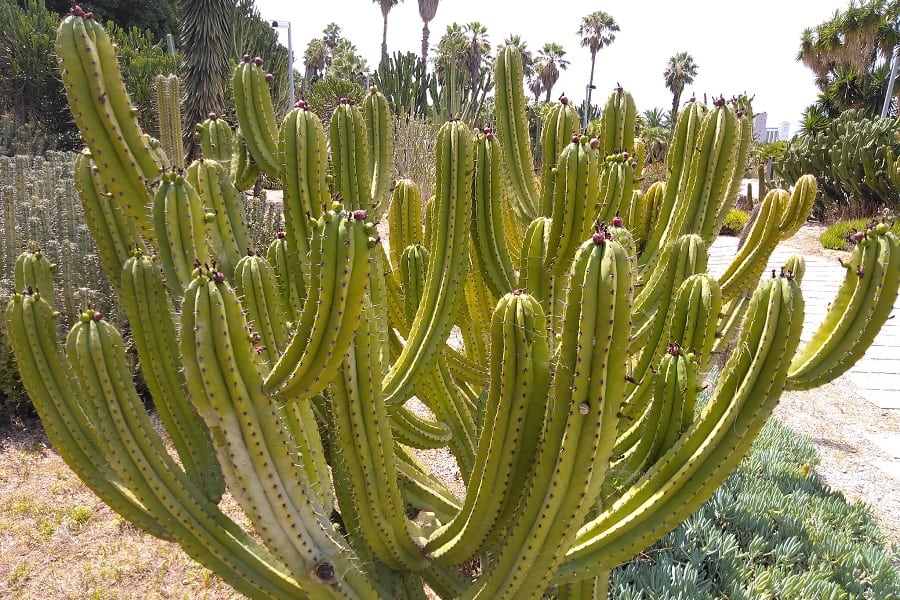4 Myrtillocactus Cacti That Will Steal Your Heart (Plus Care Tips)
Imagine a cactus that resembles a cluster of bluish-green candles reaching towards the sky. That’s the captivating Myrtillocactus cactus! These unique plants, native to Mexico and Guatemala, are sure to grab your attention with their striking appearance and easy care requirements. Let’s dive into the world of these mesmerizing cacti!

Related Post:
1,000 Types Of Cacti With Pictures
Contents
Types of Myrtillocactus Cacti
Myrtillocactus cochal

A large, sprawling shrub or small tree with compact, candelabra-like branches sprouting from a short, woody trunk. It can reach a diameter of 3 to 13 feet and a height of 3 to 13 feet, though it has a relatively short lifespan of a few decades.
Myrtillocactus eichlamii

This variety is less common in cultivation but still a sight to behold.
Myrtillocactus geometrizans (Blue Myrtle-Cactus)

The star of the show! This highly branched, columnar cactus forms a dense growth of stems growing closely together, creating a candelabra-like tree. In nature, it can reach up to 15 feet tall, with a crown spanning up to 16 feet wide.
Myrtillocactus schenckii

A towering cactus with a stout trunk and short, ascending branches, reaching up to 16 feet in height. Its whitish or cream-colored flowers are relatively small, about 1.5 inches wide, with short, protruding stamens.
Caring for Your Myrtillocactus
These fast-growing cacti can eventually reach 12 to 16 feet in height, but they take their time to develop branches, so don’t worry if yours looks like a “blue candle” for a while. The bluish-gray stems, 2 to 4 inches thick, will develop 5 to 8 ribs over time, adorned with short spines.
Light
Myrtillocactus cacti thrive in bright, direct sunlight. However, when they are young seedlings or newly propagated cuttings, it’s best to provide them with partial shade or filtered sunlight to prevent sunburn. As the plants mature and establish stronger roots, gradually introduce them to more intense sunlight. Fully grown Myrtillocactus can tolerate and benefit from full, direct sun exposure throughout the day.
Water
Like most cacti, Myrtillocactus are drought-tolerant and prefer infrequent but deep watering. During the growing season (spring and summer), allow the soil to fully dry out between waterings before soaking the potting mix thoroughly. Ensure the excess water drains away to prevent root rot. In winter, reduce watering significantly, providing only enough moisture to keep the soil from becoming bone dry.
Soil
These cacti demand well-draining soil to prevent waterlogging and root rot. Use a specialized cactus or succulent potting mix, or create your own by combining equal parts potting soil, coarse sand or grit, and perlite or pumice. The addition of gravel, crushed lava rock, or other inorganic materials can further improve drainage.
Fertilizing
During the active growing season (spring and summer), feed your Myrtillocactus with a balanced, water-soluble cactus fertilizer every 4-6 weeks. Dilute the fertilizer to half the recommended strength to avoid burning the roots. Avoid fertilizing in winter when the plants are dormant.
Temperature and Humidity
Myrtillocactus are relatively cold-hardy cacti, able to tolerate temperatures as low as 25°F (-4°C) for short periods. However, prolonged exposure to freezing temperatures can damage or kill the plant. In their native habitat, they experience warm, dry conditions, so they prefer low humidity levels indoors or in greenhouses.
Repotting
These cacti have a sprawling growth habit and can quickly become rootbound. Plan to repot every 2-3 years, or when the plant has outgrown its current container. Use a slightly larger pot with ample drainage holes, and refresh the potting mix with a well-draining cactus soil blend.
Pests and Diseases
While generally hardy, Myrtillocactus cacti can sometimes fall victim to pests and diseases, especially if grown in improper conditions.
Common Pests:
- Mealybugs – These cotton-like pests cluster in crevices and feed on plant sap, leaving behind a sticky residue.
- Spider Mites – Tiny spider-like mites that spin webs, causing stippled or bronzed patches on the stems.
- Scale Insects – Hard-shelled insects that attach themselves to the stems and suck out plant juices.
To control pests, isolate affected plants and use insecticidal soaps, neem oil, or other pesticides formulated for cacti and succulents.
Common Diseases:
- Root Rot – Caused by overwatering or poor drainage, leads to mushy, decaying roots and eventual plant death.
- Stem Rot – Usually starts at the base and works upward, causing the stem to become soft and discolored.
- Fungal Spots – Brown or black spots on the stems, potentially spreading and disfiguring the plant.
Proper watering practices and well-draining soil can help prevent most diseases. Removing affected plant parts and treating with a fungicide may control the spread.
Regular inspection and prompt treatment are key to keeping your Myrtillocactus cactus healthy and pest/disease-free. Provide the right cultural conditions, and these resilient plants can thrive for many years.
How to Propagate Myrtillocactus
Propagating these cacti is a breeze! In summer, you can take stem cuttings from your existing plant or sow seeds from ripe fruits. Here’s how:
- Gently remove stem cuttings or clean and dry seeds from ripe fruits.
- Allow stem cuttings to callus over for 2-3 weeks before planting.
- Sow cuttings or seeds in well-draining soil after the last frost.
- Water sparingly until established, then follow regular care instructions.
